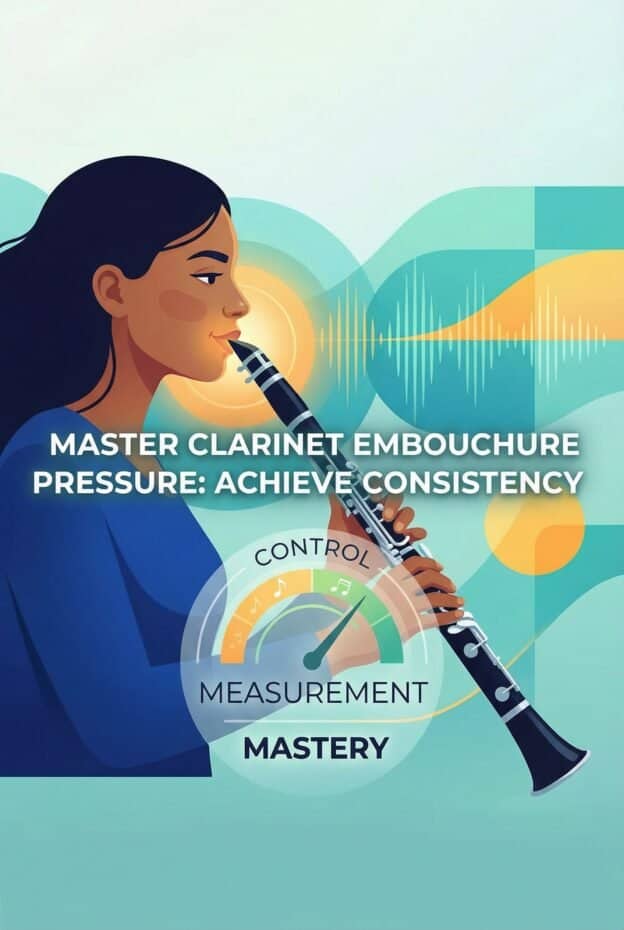What is embouchure pressure on clarinet? Embouchure pressure is the balance of lip force on the mouthpiece and the air support you use. Too much pressure chokes the reed and creates a pinched, thin tone. Too little makes the sound airy and unfocused. Aim for a light but firm seal: top teeth as a light anchor, bottom lip cushioning the reed, corners pulled gently inward, and steady diaphragmatic air support.
What is embouchure pressure and why it matters
Embouchure pressure is the combination of lip and facial muscle force on the clarinet mouthpiece, plus the air pressure from your breathing system. It controls how freely the reed vibrates, which directly shapes tone, pitch stability, dynamic range, and endurance. Efficient pressure lets the reed vibrate fully while keeping the sound focused and controllable.
On clarinet, the reed is highly sensitive to small changes in pressure. A slight increase can raise pitch and thin the sound, while a small decrease can darken the tone but risk instability. Intermediate players often struggle because they use pressure to fix problems that should be solved with air support, voicing, or equipment. Learning to separate these elements is key to reliable performance.
Embouchure pressure also affects articulation clarity and response in fast passages. If you bite to stabilize the reed, the tip cannot respond quickly to the tongue. This leads to sluggish attacks and inconsistent staccato. Balanced pressure, supported by strong air, lets the tongue work lightly while the reed stays free and responsive.
Historically, clarinet pedagogy moved from very tight, biting embouchures in early 20th century schools to more relaxed, air-focused approaches as repertoire and performance demands expanded. Modern methods, influenced by research shared through organizations like the International Clarinet Association, emphasize efficient pressure and flexible tone across styles from Mozart to contemporary works.
Clarinet embouchure anatomy: teeth, lips, reed and mouthpiece roles
Good embouchure pressure starts with clear anatomical roles. The top teeth rest lightly on the mouthpiece beak, usually with a patch for comfort. They act as a stable anchor, not a clamp. The lower lip folds slightly over the bottom teeth to form a cushion for the reed, controlling vibration without crushing it.
The mouth corners pull gently inward toward the reed, not backward into a smile. This inward motion creates a seal around the mouthpiece and supports the chin muscles. The chin should feel flat and firm, pointing slightly downward, which helps distribute pressure evenly along the reed and mouthpiece rather than concentrating it at the tip.
The reed itself is a flexible spring. When air passes between the reed and mouthpiece, the reed vibrates against the facing curve. If your bottom lip presses too hard, it restricts this motion and the sound becomes thin and sharp. If the lip is too loose, the reed slaps and leaks air, creating airy tone and squeaks.
The mouthpiece design also shapes how pressure feels. A more open tip and longer facing usually need slightly more lip support and air, while a closer tip and shorter facing respond with less pressure. Intermediate players should work with a teacher to choose a mouthpiece that allows balanced pressure without constant biting or collapsing.
The tongue, jaw, and throat (voicing) interact with embouchure pressure too. A high tongue position and open throat support stable pitch without extra lip force. If you drop the tongue or tighten the throat, you may instinctively increase embouchure pressure to compensate, which can start a cycle of tension and fatigue.
How to tell: signs of too much, too little, and just-right pressure
Too much embouchure pressure usually sounds like a thin, bright, or nasal tone. Notes feel hard to start softly, and high notes may be sharp or unstable. Your jaw and lip muscles tire quickly, especially in long rehearsals or loud passages. You might see teeth marks on your lower lip after playing, a classic sign of biting.
Too little pressure produces an airy, fuzzy, or unfocused sound. The reed may squeak or double-sound when you change registers or intervals. Articulation feels mushy, and low notes may drop out or crack. You might notice air leaking from the corners of your mouth, or feel the mouthpiece moving around instead of staying stable.
Just-right embouchure pressure gives a centered, resonant tone that responds easily at all dynamics. Long tones feel stable, and you can crescendo and decrescendo without the pitch drifting sharply up or down. Register changes, such as low C to high G, feel predictable, with minimal embouchure adjustment beyond voicing and air support.
A useful test is to play a comfortable note like open G and slowly reduce lip pressure while keeping air steady. At a certain point, the tone will start to spread or wobble. Then slowly increase pressure until the sound becomes pinched. The ideal zone is between these extremes, where the tone is clear, full, and flexible.
Another sign of balanced pressure is how your face feels after practice. Mild muscle fatigue is normal, especially when building strength, but sharp pain in the jaw joint or biting pain in the lower lip indicates excess pressure. If you can play 30 to 45 minutes of focused practice without painful tension, your pressure is likely in a healthy range.
Step-by-step exercises to develop steady embouchure pressure
Steady embouchure pressure is built through slow, focused drills. Long tones are the foundation. Start on middle G, hold for 8 to 12 counts at a comfortable mezzo-forte, and listen for a stable, centered sound. Keep the jaw and lips steady while you vary dynamics using air, not extra pressure.
Next, add crescendo and decrescendo within a single long tone. Begin soft, grow to strong, then return to soft, all on one breath. Watch that the pitch does not rise when you get louder or sag when you get softer. If it does, you are probably changing embouchure pressure instead of air speed and support.
Use a tuner or tuning app to monitor pitch while you experiment. Hold a note and slightly relax the bottom lip, then slightly firm it, observing how the pitch moves. This teaches you how little pressure change is needed to adjust intonation, and helps you avoid big, tension-filled corrections in performance.
Another useful drill is the “pressure ladder.” Choose a note, then play it in short, repeated tones, each one slightly softer than the last, without changing mouthpiece position. Focus on keeping the embouchure shape consistent while relying on air control to reduce volume. Reverse the ladder to grow from soft to loud without biting.
For endurance, practice 2 to 3 minute continuous long-tone patterns, such as moving slowly from low E to open G and back, using smooth slurs. Keep the jaw and lip pressure as constant as possible while the fingers move. This simulates real music while training you not to clamp down during technical changes.
HowTo: Long tone embouchure pressure drill
Goal: Build consistent, efficient embouchure pressure with stable tone and pitch.
- Choose a comfortable note like open G or middle F.
- Set a metronome to 60 bpm and a tuner where you can see it.
- Form your embouchure: top teeth lightly on the mouthpiece, bottom lip cushioned over teeth, corners in, chin flat.
- Take a deep breath using your diaphragm and start the note at mezzo-forte.
- Hold for 8 beats, keeping the tuner needle centered and the tone steady.
- Repeat 5 to 10 times, then move to neighboring notes, keeping the same embouchure feel.
Pressure distribution techniques and mouthpiece placement adjustments
Embouchure pressure is not just about how hard you press, but how you distribute that force. Aim for vertical support from the top teeth to the bottom lip, with the corners and chin providing gentle horizontal stability. Avoid concentrating pressure at the very tip of the reed, which often causes sharp pitch and fatigue.
Think of the bottom lip as a cushion that supports the reed along a small area, not a clamp at one point. Some players benefit from slightly rolling more lip over the teeth to increase cushioning, especially with stronger reeds. Others need less roll to avoid muffling the sound. Experiment slowly while listening for clarity and comfort.
Mouthpiece placement is important. Too little mouthpiece in the mouth forces you to bite to keep the reed vibrating. Too much can make control difficult and encourage sagging pitch. A common starting point is to place the mouthpiece so that when you look in a mirror, you see about 8 to 12 millimeters of reed inside your mouth.
To find your personal placement, try the “crow” test. Put the mouthpiece and reed alone in your mouth, form your embouchure, and blow. Adjust how far you insert the mouthpiece until you get a strong, crow-like squawk. Then back off slightly until the sound is full but controllable. This position usually translates well when the mouthpiece is on the clarinet.
Pressure distribution also changes slightly between registers. In the chalumeau (low) register, you may feel a bit more cushion in the lower lip to keep the reed stable at softer dynamics. In the clarion and altissimo, think of slightly firmer corners and a more focused air stream, rather than extra jaw pressure, to keep notes secure.
Use a mirror to check that your corners move inward, not backward, and that your chin stays flat rather than bunched. Small visual cues often reveal hidden tension patterns that affect how pressure is distributed across the reed and mouthpiece.
Breathing and air-pressure control: diaphragm support & mirror fogging drill
Embouchure pressure only works well when paired with steady, efficient air support. The diaphragm and surrounding muscles create the air pressure that drives the reed. If air is weak or uneven, you may overuse lip pressure to compensate, which leads to fatigue and instability.
Start with basic breathing: inhale through the mouth as if sipping through a straw, feeling expansion in the lower ribs and abdomen. Avoid lifting the shoulders. Exhale with a steady hiss, imagining you are fogging a mirror from a distance. This trains consistent airflow without sudden bursts or drops.
On the clarinet, think of air speed rather than sheer force. Higher notes and softer dynamics often need faster, more focused air, not tighter embouchure. Practice long tones while focusing on a smooth, spinning air column, keeping the throat open as if saying “ah” or “ee” inside the mouth.
HowTo: Mirror fogging air support drill
Goal: Coordinate air pressure with embouchure pressure for stable tone.
- Stand or sit with good posture, holding the clarinet ready to play.
- Place a small mirror about 20 to 30 centimeters in front of your mouth.
- Without the clarinet, exhale onto the mirror to create a steady fog for 4 to 6 seconds.
- Repeat, aiming for the same size and density of fog on each breath.
- Now play a long tone on open G while looking at the mirror, watching that your jaw and lips stay still as the air flows.
- Alternate between fogging the mirror and playing the note, matching the feeling of steady air in both.
This drill teaches you that the embouchure should feel stable while the air does the dynamic work. If the mirror fog pulses or breaks, your air is uneven, which often leads to unconscious changes in embouchure pressure. Smooth, consistent fog usually matches stable tone and pitch.
Maintenance steps that affect embouchure pressure (reed, mouthpiece, instrument checks)
Equipment problems often force players to use unhealthy embouchure pressure just to make the clarinet respond. Regular maintenance lets you use natural, efficient pressure instead of fighting leaks or dead reeds. Start every troubleshooting session by checking the reed, mouthpiece, ligature, and instrument condition.
Inspect the reed for chips, warping, discoloration, or soft, spongy response. A worn reed often squeaks, feels unstable, or requires extra pressure to stay in tune. Rotate at least 3 to 4 reeds in daily use so no single reed wears out too quickly. Replace reeds that feel dull or unresponsive even with good embouchure and air.
Check reed alignment on the mouthpiece. The reed tip should line up evenly with the mouthpiece tip, with equal side rails visible on both sides. If the reed is off-center or too low, you may bite to correct response. Adjust gently until the reed sits straight and secure under the ligature.
Examine the mouthpiece for cracks, chips, or buildup. A dirty facing can change how the reed seals and vibrates, leading to inconsistent response that tempts you to overpress. Clean the mouthpiece regularly with lukewarm water and a soft brush, avoiding hot water that could warp the material.
Ligature tension also affects embouchure pressure. Too tight and the reed cannot vibrate freely; too loose and it may slip or leak. Aim for firm but not crushing tension, usually just past snug on both screws. Experiment with small adjustments to find the setting that gives the clearest response with the least embouchure effort.
Finally, have a technician check for instrument leaks, especially around the upper joint and register key. Leaks often cause weak low notes and unstable response that players unconsciously fix by biting or squeezing. A well-sealed clarinet allows you to use lighter, more efficient embouchure pressure.
Troubleshooting common problems (squeaks, fatigue, pitch instability)
Squeaks are often the most frustrating sign of embouchure pressure problems. They usually come from a mix of uneven pressure, unstable air, and reed issues. If you squeak on slurs or register changes, first confirm that the reed is in good condition and properly aligned. Then check that your bottom lip is cushioned and centered under the reed, not sliding or collapsing.
Practice slow slurs between problem notes, such as throat A to clarion E, focusing on steady air and minimal embouchure movement. If squeaks persist, slightly reduce pressure while increasing air speed. Many players discover they had been clamping too hard, preventing the reed from transitioning smoothly between vibration patterns.
Fatigue usually signals excess pressure or inefficient distribution. If your jaw or lip tires after short practice sessions, record yourself in a mirror. Look for bunched chin muscles, pulled-back corners, or jaw thrusting. Work on relaxing non-important muscles while keeping only a light, focused seal around the mouthpiece.
Pitch instability, especially sharpness, often comes from biting as you go higher or louder. Use a tuner to play scales slowly, watching how pitch changes with dynamics. Aim to keep the tuner centered by adjusting air and voicing first. Only use tiny embouchure adjustments as a last resort.
If notes sag flat when you play softly, you may be relaxing both air and embouchure too much. Try keeping the embouchure shape steady while increasing air speed slightly, even at low volume. Think of blowing warm but focused air, like gently blowing out a candle without flickering the flame.
When troubleshooting, change one variable at a time: reed, mouthpiece placement, lip pressure, air support. This systematic approach helps you understand cause and effect, so you can fix issues quickly in rehearsals and performances instead of guessing.
Practice plans and expected player outcomes (endurance, tone quality, range)
A structured practice plan turns embouchure pressure concepts into real results. For intermediate players, 20 to 30 minutes per day focused on tone and pressure can transform consistency within a few weeks. Divide this time between long tones, dynamic control, register transitions, and brief endurance work.
Sample 20-minute plan: 5 minutes of long tones with tuner, 5 minutes of crescendo-decrescendo drills on sustained notes, 5 minutes of slow register slurs (chalumeau to clarion), and 5 minutes of short endurance patterns such as 2-minute continuous slurred scales with steady embouchure. Keep a simple log to track which notes or registers feel unstable.
After 2 to 4 weeks, you should notice clearer tone, fewer random squeaks, and less facial fatigue. Range often improves because altissimo notes respond better when the reed is not over-clamped. Dynamic control becomes smoother, with less pitch drift at soft volumes and more power available at forte without strain.
Teachers can use these drills to give students measurable goals, such as holding a note for 12 beats with stable pitch, or playing a full octave slur without embouchure shifts. Recording weekly progress helps students hear subtle improvements that might be hard to notice day to day.
Advanced players can adapt the same principles to demanding repertoire. For example, practice difficult passages at half tempo with a focus on embouchure stability, then gradually increase speed while keeping the same pressure feel. This prevents tension from creeping in when technical demands rise.
Key takeaways
- Embouchure pressure should be light but firm, with top teeth as an anchor, bottom lip cushioning the reed, and corners inward for a stable seal.
- Use long tones, dynamic drills, and mirror fogging exercises to separate air control from lip pressure and build consistent tone.
- Regular reed rotation, mouthpiece cleaning, and leak checks prevent equipment issues that force unhealthy embouchure pressure.
- Track practice time and pitch stability to measure progress in endurance, tone quality, and range over several weeks.
FAQ
What is embouchure pressure?
Embouchure pressure is the combined force of your lips, facial muscles, and jaw on the clarinet mouthpiece, plus the air pressure from your breathing. It controls how the reed vibrates, which affects tone, pitch, dynamics, and endurance. Balanced pressure lets the reed vibrate freely while keeping the sound focused and stable.
How can I tell if I'm using too much embouchure pressure?
Signs of too much pressure include a thin or bright tone, sharp pitch, quick lip or jaw fatigue, and difficulty playing softly without the sound cutting out. You may also see teeth marks on your lower lip. If relaxing slightly while increasing air improves the sound, you were likely pressing too hard.
What exercises help build embouchure endurance and control?
Long tones with a tuner, crescendo-decrescendo drills, slow register slurs, and 2 to 3 minute continuous slurred patterns all build endurance and control. Practice 5 to 10 minutes of long tones daily, focusing on steady pitch and tone, then add short endurance sessions where you keep the embouchure stable while fingers move.
Does mouthpiece placement affect embouchure pressure?
Yes. If you take too little mouthpiece, you often have to bite to keep the reed vibrating. Too much mouthpiece can make control difficult and encourage sagging pitch. A typical starting point is 8 to 12 millimeters of reed in the mouth, adjusted using the crow test to find a strong but controllable response.
When should I change my reed if I have pressure-related issues?
Change your reed if it looks chipped, warped, discolored, or feels dull and unresponsive even with good air and embouchure. Persistent squeaks, sudden instability, or needing much more pressure than usual to stay in tune often signal a worn reed. Rotating 3 to 4 reeds helps you notice when one starts to fail.







